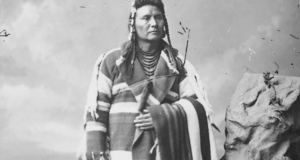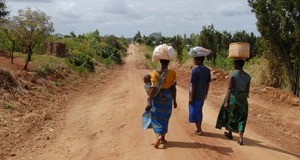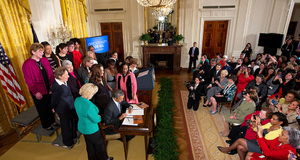From Discussions VOL. 11 NO. 2The Human Rights Impacts of VAWA 2013: A True Victory for Native American Women?
IN THIS ARTICLE
The level of gender violence against native women in the United States has reached epidemic proportions. Furthermore, the vast majority of Native American gender violence victims are abused at the hands of non-native men. Native American tribes are considered to be “domestic dependents” of the United States, meaning that they have the inherent authority to govern themselves and also maintain U.S. citizenship rights. This system creates multiple overlapping governing systems on tribal reservations, as illustrated by determining jurisdiction over gender violence crimes. Tribal courts do not have the power to persecute non-native persons, and federal prosecutors, who do have jurisdiction, have declined approximately two-thirds of sexual abuse cases from Native Americans in recent years. Native women are essentially left legally defenseless against sexual abuse. Consequently, Native Americans have reached out to the international human rights community for support in gaining more legal protection for the victims of gender violence. Independent international experts and human rights organizations have repeatedly called on the United States to take action and increase legal protection for Native American women. Amnesty International claims that “In failing to protect Indigenous women from sexual violence, the US is violating these women’s human rights.” The human rights organization is calling on the United States government to take necessary steps to end sexual violence against Native American women. James Anaya, the United Nations Special Rapporteur on the Rights of Indigenous Peoples, also expressed concern about the prevalence of gender violence on Native American reservations. Following his visit to the United States in 2012, he reported that numerous cases of violence against native women are committed by non-native individuals, many of whom are not subject to indigenous prosecutorial authority because of their non-native status. He asserts that “Congress should act promptly to pass key reforms to the Violence Against Women Act that bolster indigenous tribes’ ability to prosecute cases involving violence against indigenous women.” Fortunately, in March of 2013 the Violence Against Women Act (VAWA) was reauthorized to include a provision, which gave tribal governments criminal jurisdiction over some non-Indians who commit crimes on reservations. This recent legislation is hailed as a victory for indigenous women seeking justice and protection from the legal system, but there are also many critics and notable shortcomings of the new provision. This paper seeks to examine whether the reauthorized Act is truly a victory for Native American women and if it adequately protects their human rights. This study will focus on three key human rights established by the United Nation’s Declaration of Human Rights: “the right to life, liberty and the security of person, the right to recognition and equality everywhere as a person before the law, and the right to an effective remedy by the competent national tribunals for acts violating the fundamental rights granted him by the constitution or by law”. History of Gender Violence and Tribal JurisdictionSexual abuse against Native American women is astonishingly prevalent and particularly violent. According to U.S. Department of Justice, Native American women are more than two and a half times more likely to be raped or sexually assaulted than are other women in the United States. Approximately one in three Native American women will be raped in their lifetimes. This rate is most likely even higher due to the underreporting of sexual violence crimes; according to the Department of Justice, seventy percent of sexual assaults of Native women are never reported. Many of the Native American women interviewed by Amnesty International said they did not know of any women in their community who had not experienced sexual violence. Furthermore, there is evidence that native women are more likely than other American women to suffer additional violence at the hands of their attackers. Rapes against native women are three times more likely to involve weapons than all other rapes in the United States. In a 2006 study, ninetysix percent of American Indian respondents who had been a victim of rape or sexual assault had experienced other physical abuse as well. Lisa Brunner, the Director of the Sacred Spirits First Nations Coalition and advocate for the survivors of sexual violence in the Native American community, says that rates of rape are so high in her community that girls discuss rape in terms of what to do “when raped,” and not “if [I am] raped.” She recalls what one young girl told her: “My mom and I already talked about that. When I’m raped, we won’t report it, because we know nothing will happen. We don’t want to cause problems for our family.” Sexual assaults are a constant threat and, as illustrated by Lisa Brunner’s experience, a definite reality in native women’s lives. According to the US Department of Justice, in at least eighty-six percent of the reported cases of rape or sexual assault against Native American women, victims report that the perpetrators are non-Native men. This represents a substantially higher rate of interracial sexual violence than is experienced by Anglo or African American women within the United States. Reservation demographics are partially responsible for this. A significant portion of residents on most reservations are non-Indian, largely a result of the United States government’s sale of tribal land to white settlers around the turn of the century. More than half of all married Native American women have non-native husbands and, arguably as a consequence, Native American women experience some of the highest domestic-violence victimization rates in the country. However, reports also state that sexual predators from outside tribal lands will often travel to reservations with the intent to rape. Accounts of violence against women living in tribal communities generally increase during hunting season. Historically, Indian tribes have exercised full authority over its inhabitants. Early federal treaties specifically noted a tribe’s power to punish non-Indians. However, towards the end of the nineteenth century, there was a push within the United States government to dismantle tribal government systems. Criminal law enforcement, especially in cases involving non-Indians, became federal or state matters, and tribal court powers became increasingly limited. In 1968, the Indian Civil Rights Act limited the criminal sentences that tribal courts could impose up to one year in jail and a $5,000 fine. To put this restriction into perspective, in cases of rape, state court sentences typically exceed eight years and federal sentences generally surpass twelve. Moreover, in the 1978 case Oliphant v. Suquamish Indian Tribe the Supreme Court ruled it unconstitutional for tribal courts to try nonnatives without Congress’ consent. This was an injustice to Indian victims of all crimes, but most exacerbated in regards to gender violence because sexual assaults on Native American women are overwhelmingly interracial. David Perez, a graduate of Yale Law School and legal commentator, states, “the biggest problem Native American women face isn’t related to crimes committed by Native Americans—it’s crimes committed by non-Indians on tribal land. But those who commit violence against women on tribal lands are roaming this legal maze with absolute impunity.” Native women who come forward today to report sexual violence are caught in a jurisdictional maze between three justice systems: tribal, state and federal. Whether the victim is a member of a federally recognized tribe, the accused is a member of a federally-recognized tribe, and whether the offence took place on tribal land, are the three most significant deciding factors in determining which justice system has the authority to prosecute the crime. David Perez explains that, “if neither the victim nor the perpetrator is Native American, then only State authorities can make the arrest and try the case. If the victim is Native American, but the perpetrator is not, then only federal agents can make the arrest. And if the victim is not Native American, but the perpetrator is? Then tribal authorities can make the arrest, but only federal courts would have jurisdiction to try the case.” There are often significant delays before police, lawyers, and courts can eventually agree upon who has jurisdiction over a particular crime. There have even been cases where there was so much confusion over jurisdiction that the case was never tried. The bureaucracy regarding jurisdiction has ultimately led to inefficient law enforcement on tribal lands. According to recent studies, law enforcement on reservations rarely leads to prosecution and conviction of non-Indian offenders. N. Bruce Duthu points out in the New York Times article “Broken Justice in Indian Country” that “the Department of Justice’s own records show that in 2006, prosecutors filed only 606 criminal cases in all of Indian country. With more than 560 federally recognized tribes, that works out to a little more than one criminal prosecution for each tribe.” This situation is the result of not only jurisdictional confusion, but also the lack of law enforcement officers in tribal communities. There is less law enforcement per capita in tribal communities than there is in other rural areas nationwide. A 2001 survey of police departments on tribal reservations across the country found that many tribal police departments are underfunded and lack necessary resources like sufficient staffing (administrative and law enforcement personnel), technology, vehicles, and equipment. The lack of available resources means that law enforcement responses to crime scenes are extremely delayed. Furthermore, upon arrival the officer must first take the time to determine whether the crime is within tribal jurisdiction. If not, the state or federal law enforcement officers must be contacted, creating even more delay before the investigation may begin and the victim is actually tended to. Moreover, federal and state prosecutors often lack the time and resources to pursue cases, and yet they are responsible for all cases involving non-native offenders. According to the Government Accountability Office, between 2005 and 2009, 67 percent of sexual abuse cases sent to the federal government for prosecution were declined. Although the Justice Department claims it has mandated extra training for prosecutors and has directed each field office to develop its own plan to help reduce violence against women, there have been no significant or quantitative improvements in recent years. Some advocates for Native American women say they no longer urge victims to report rapes. Even if a case is accepted by the federal government, relying on federal or state authorities often means having to travel hundreds of kilometers to the nearest forensic examiner or prosecutor. Sarah Deer, an assistant professor of law at William Mitchell College and a citizen of the Muscogee Nation of Oklahoma, states: “There’s never really been accountability for non- Indians coming into tribal communities and committing acts of rape or domestic violence; tribal governments can’t prosecute them. I’ve heard tribal police say that the white men on the reservation basically flaunt their violence and taunt the police: ‘You can’t do anything, I know I’m outside the bounds of the law.” The United States legal system essentially leaves Native American women helpless and vulnerable. According to Colorado State University expert Roe Bubar, an assistant professor in the school of Social Work and Ethnic Studies and Pamela Jumper Thurman, a senior researcher at the Tri-Ethnic Center for Preventative Research , “The message to Native women and their children is that they are expendable and there is no real help or assistance within the system.” Violence Against Women ActThe Violence Against Women Act is a segment of the Violent Crime Control and Law Enforcement Act of 1994. VAWA has been widely credited with helping law enforcement and prosecutors crack down on domestic violence nationwide. The Act provides additional tools for protecting women on native reservations by defining a new federal habitual-offender crime penalty and authorizing warrantless arrests to federal law enforcement officers who determine probable cause during domestic violence cases. VAWA also created the Violence Against Women Office (VAWO), which currently administers 21 grant programs and subsequent legislation, four of which are specifically targeted to Native American populations. On March 7, 2012, Congressman Dan Boren introduced the Stand Against Violence and Empower (SAVE) Native Women Act in addition to VAWA. The Act allows tribes to exercise sovereignty in investigating, prosecuting, convicting, and sentencing both Native Americans and non-natives who assault Native American partners in native lands. The reauthorized Act also clarifies tribes’ sovereign power to issue and enforce civil protection orders against natives and non-natives. According to the Act, tribes’ criminal jurisdiction over non-natives is limited to domestic violence crimes, dating violence, and criminal violations of protection orders. Crimes between two strangers (including sexual assaults), crimes committed by a person who lacks sufficient ties to the tribe, child and elder abuse that does not involve the violation of a protection order, and crimes between two non-natives are still not protected against. In addition to addressing issues of jurisdiction, the SAVE Act requires the Attorney General to submit an annual report of suggestions given by Indian tribes and actions taken to respond to recommendations from years prior. The purpose of these annual reports is to facilitate cooperation and consultation between tribes and law enforcement agencies. The other major additions to VAWA that the 2013 reauthorization creates, aside from the sovereignty of tribal courts, is the protection against intimate partner violence of lesbian, gay, bisexual, and transgender people and extended access to United States’ visas for immigrant victims. Ultimately, the reauthorized act extends the protections against gendered violence to minorities who did not receive the full benefit of the original Violence Against Women Act in 1994. A strengthened version of the Violence Against Women Act was signed by President Obama on March 7, 2013. It is still hailed as a great victory for Native American women. When President Obama signed the reauthorization, he commented, “This is the day of the advocates, the day of the survivors. This is your victory. This victory shows that when the American people make their voices heard, Washington listens.” Native Americans are commonly thought of as the biggest benefactors of the reauthorization. “It’s a great victory for women everywhere but especially tribal women,” said Rep. Ann Kirkpatrick. Secretary of the Interior Ken Salazar praised the new Act, stating, “This historic legislation, which recognizes and affirms inherent tribal jurisdiction over non-Indians in domestic violence cases, will provide much needed tools to tribal justice systems to effectively protect Indian women from abuse.” This new law takes general effect on March 7, 2015, but it also authorizes a voluntary “Pilot Project” to allow certain tribes to begin exercising SDVCJ sooner. Today, there is barely any public discourse regarding the remaining limitations of the new Act.Continued on Next Page » Suggested Reading from Inquiries Journal
Inquiries Journal provides undergraduate and graduate students around the world a platform for the wide dissemination of academic work over a range of core disciplines. Representing the work of students from hundreds of institutions around the globe, Inquiries Journal's large database of academic articles is completely free. Learn more | Blog | Submit Latest in Women's & Gender Studies |



















